| DESCRIPTIONS | INTRODUCTION & HISTORY |
Please Click On Any Picture for a Larger Version
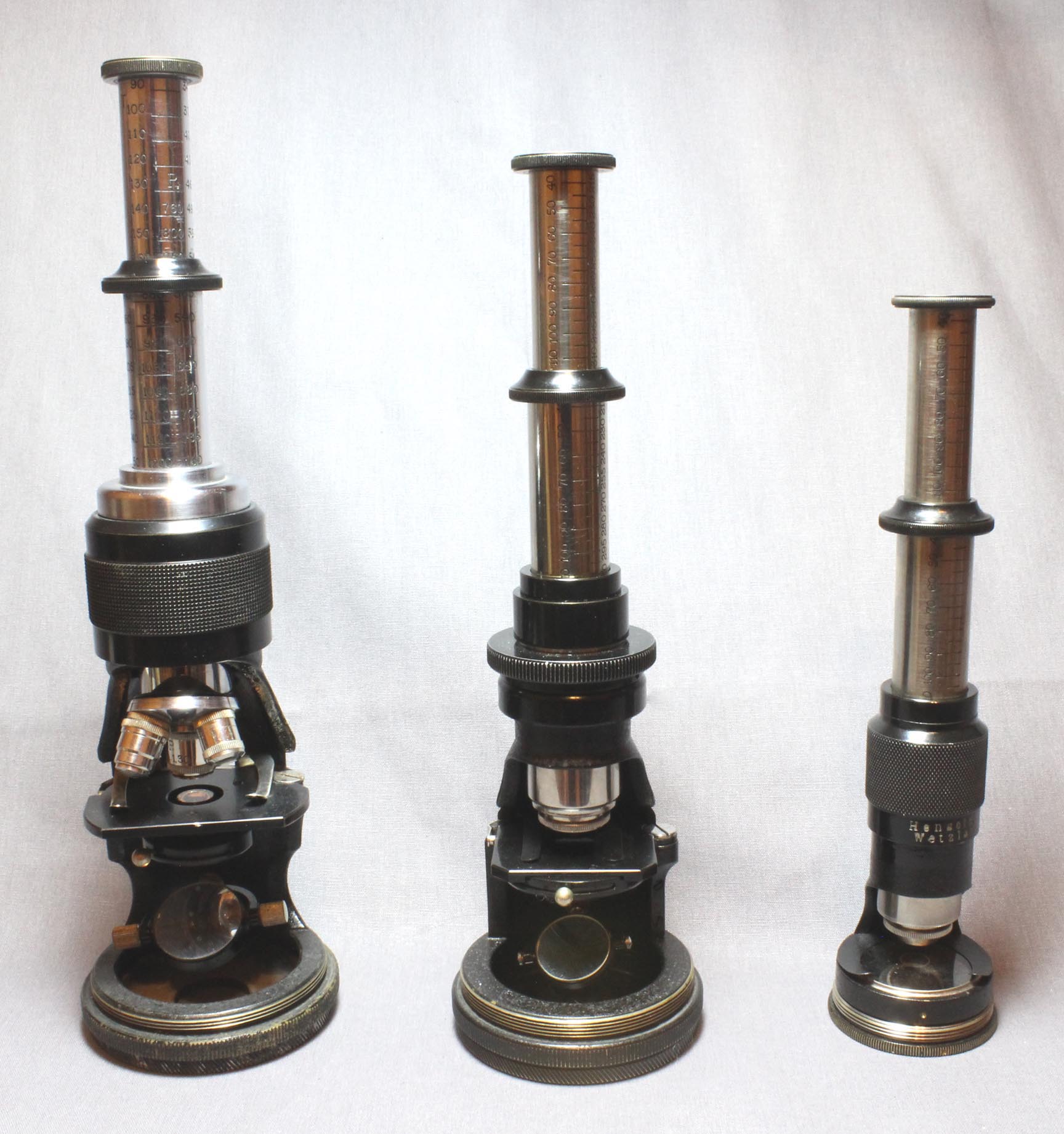
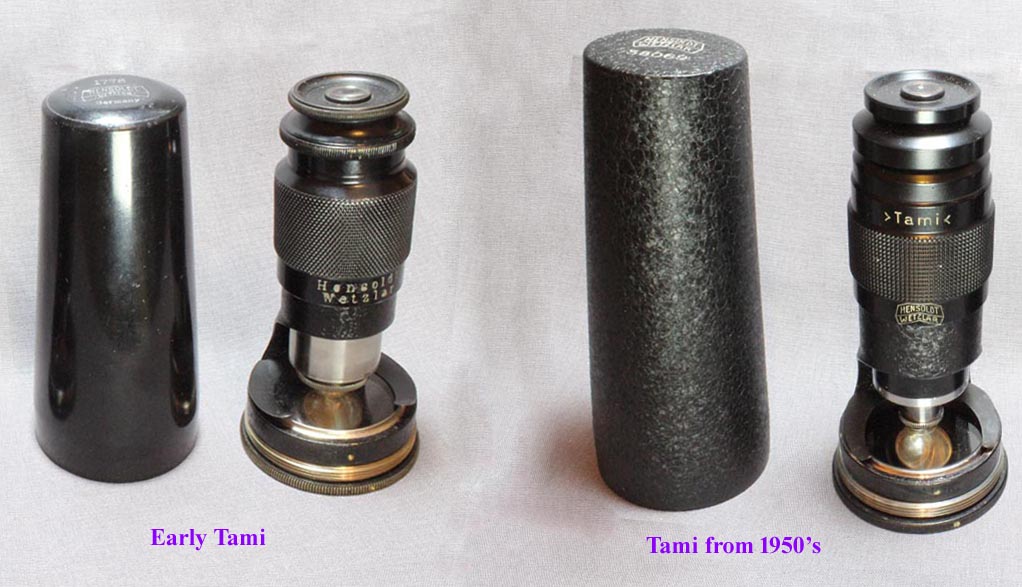
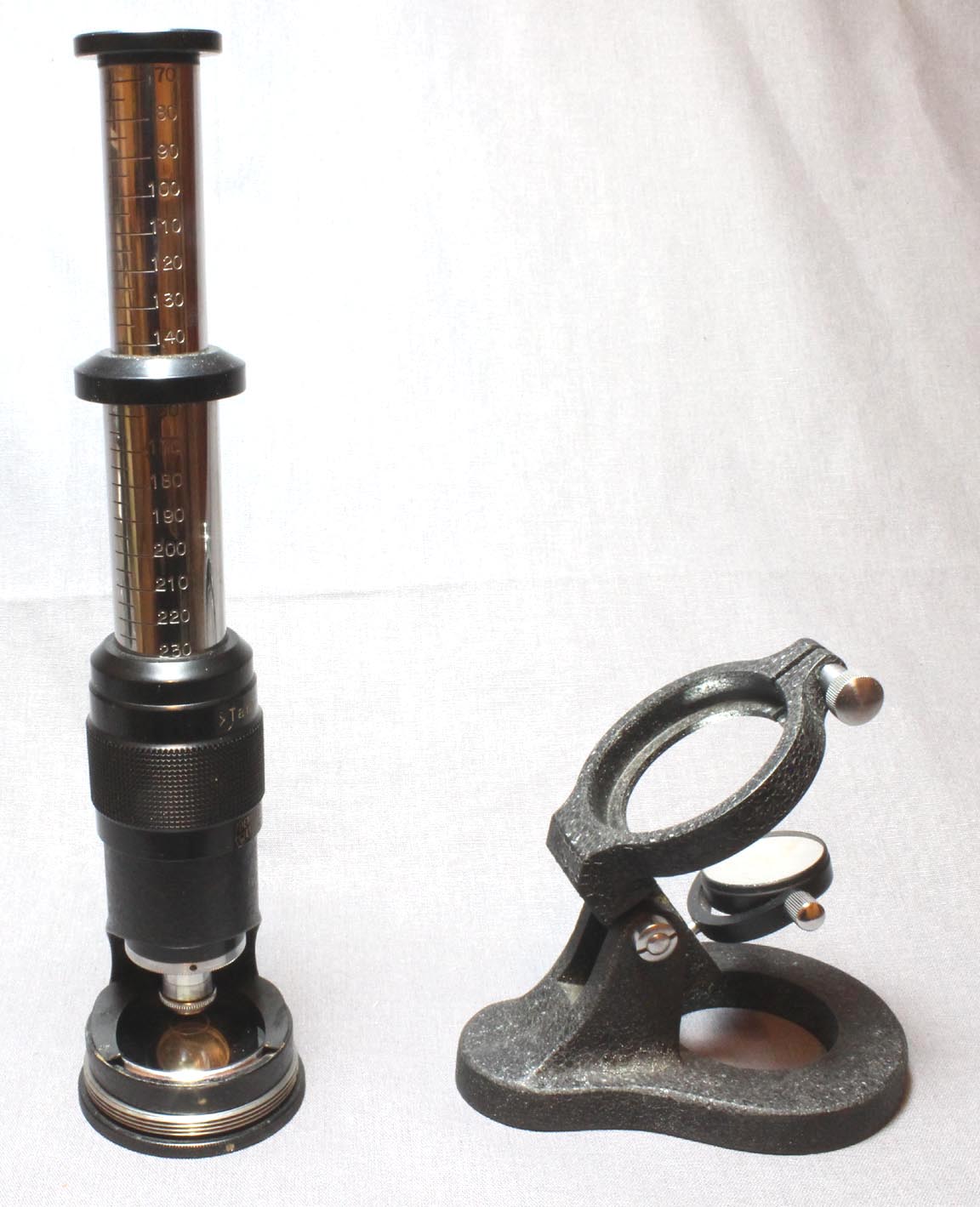
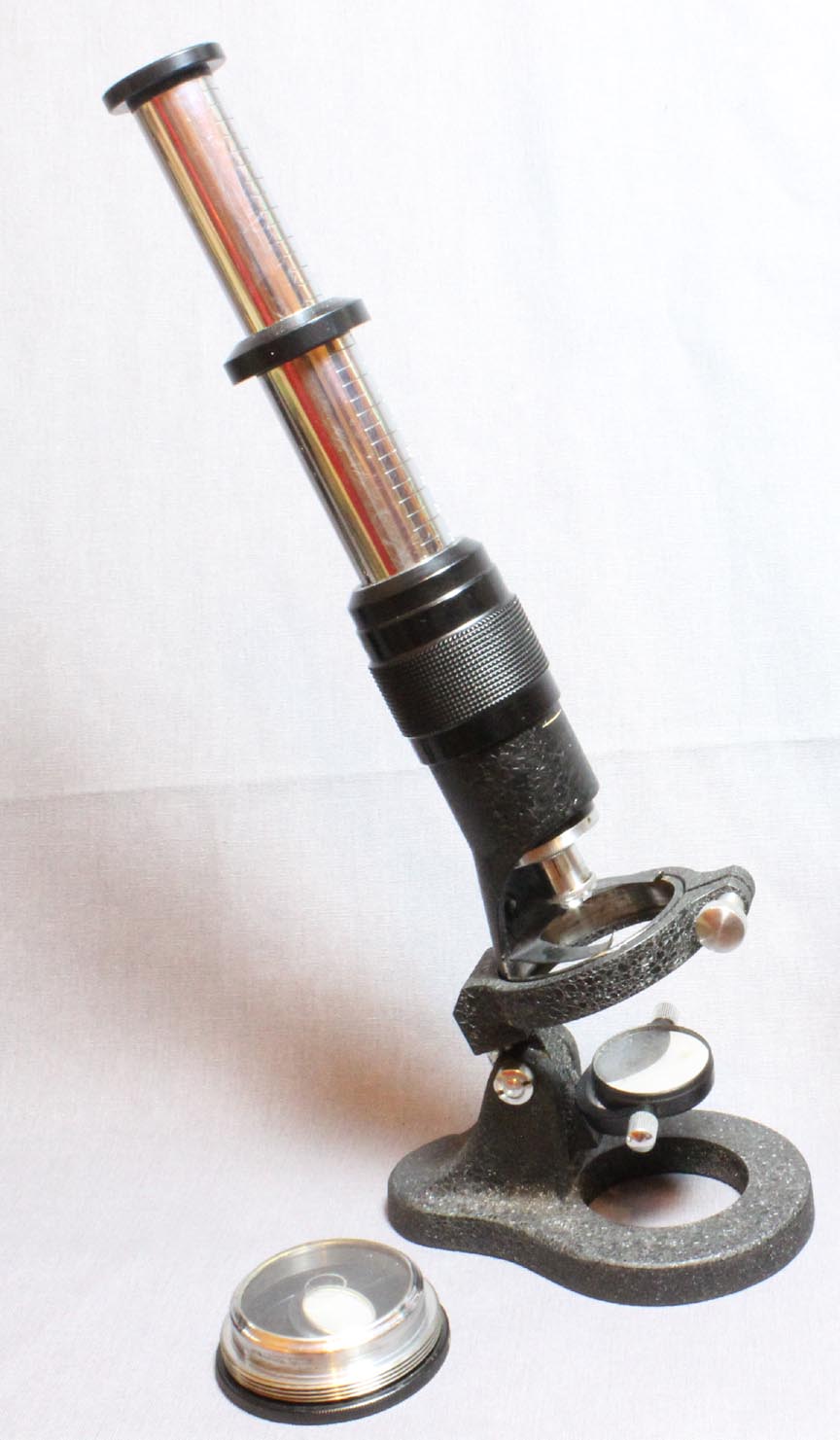
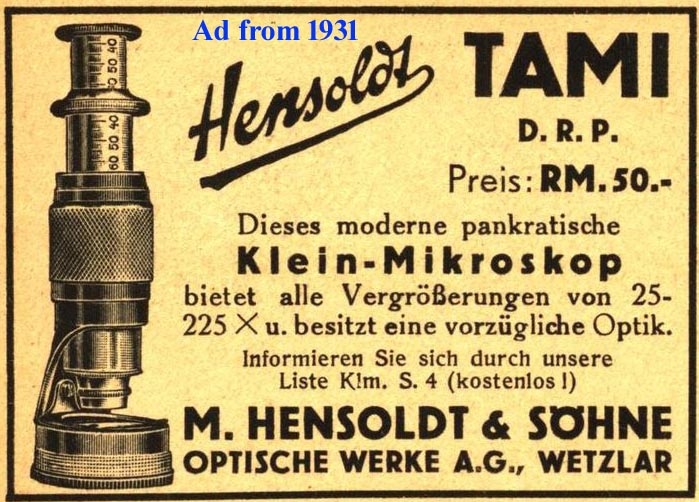 The concept of a 'pocket microscope' dates back to the 18th century. Although this idea persisted more or less through the years that followed, a period of greater interest in pocket instruments, particularly modern achromatic ones, started with the introduction of the Hensoldt Tami in the 1920's. These microscopes by Hensoldt of Wetzlar, Germany are rugged and highly portable instruments. The Tami, smallest of the three was the first by Hensoldt marketed as a 'pocket microscope.' The Tami was patented in the U.S.A. on June 6, 1922, patent number 1,418,645. As the craze for good quality 'pocket' instruments developed, the Hensoldt line competed with instruments by such makers as Goerz and Leitz in Germany and by the 1930's, foreign makers such as Baker, Bausch & Lomb, and Spencer. McArthur's microscope, although invented in the 1930's was not produced in large numbers until after WWII. The Tami, was patented in Germany in 1921 and in the United States in 1922. An attachable electric light source usable for both top lighting and reflected lighting is shown in the U.S. Patent of 1922. This was apparently powered by household current, and therefore the utility of this lighting system would be lost in field use. The introduction of the Tami was followed by the larger Metami (from about 1923 to 1928), and the more sophisticated Protami (from about 1925 to 1939). As originally designed, these were of high quality but had several drawbacks, common to all three models. One of the drawbacks was that they were all vertical microscopes which did not incline, which made them uncomfortable to use for any prolonged period of time. This problem was solved by an accessory available no later than 1932. This accessory, when attached to the bottom of the microscopes, allowed the user to easily change the configuration of the microscope (both the Tami and the Protami), to allow inclination. Other problems remained though, such as having to turn the fine focus all the way down to store the instrument and turn it quite a long ways in the other direction to actually allow focusing after removing its cover. This latter problem was solved later on by making the cover longer. They were also quite expensive, especially early in their production. Nevertheless these are rugged instruments and their sturdy dustproof covers protect them well when not in use. Their optical performance is very good for the time they were made. Although production of the Metami and Protami ceased in the second quarter of the twentieth century, the production of the original Tami was continued well into the 1950's, and improved versions, with inclination built-in, even later. Later, as is illustrated by the image on the right above, the finish on the Tami changed from a smooth to a 'crinkle' finish, and the cover was taller, obviating the tedious task of turning of the tube all the way down for storage.
The concept of a 'pocket microscope' dates back to the 18th century. Although this idea persisted more or less through the years that followed, a period of greater interest in pocket instruments, particularly modern achromatic ones, started with the introduction of the Hensoldt Tami in the 1920's. These microscopes by Hensoldt of Wetzlar, Germany are rugged and highly portable instruments. The Tami, smallest of the three was the first by Hensoldt marketed as a 'pocket microscope.' The Tami was patented in the U.S.A. on June 6, 1922, patent number 1,418,645. As the craze for good quality 'pocket' instruments developed, the Hensoldt line competed with instruments by such makers as Goerz and Leitz in Germany and by the 1930's, foreign makers such as Baker, Bausch & Lomb, and Spencer. McArthur's microscope, although invented in the 1930's was not produced in large numbers until after WWII. The Tami, was patented in Germany in 1921 and in the United States in 1922. An attachable electric light source usable for both top lighting and reflected lighting is shown in the U.S. Patent of 1922. This was apparently powered by household current, and therefore the utility of this lighting system would be lost in field use. The introduction of the Tami was followed by the larger Metami (from about 1923 to 1928), and the more sophisticated Protami (from about 1925 to 1939). As originally designed, these were of high quality but had several drawbacks, common to all three models. One of the drawbacks was that they were all vertical microscopes which did not incline, which made them uncomfortable to use for any prolonged period of time. This problem was solved by an accessory available no later than 1932. This accessory, when attached to the bottom of the microscopes, allowed the user to easily change the configuration of the microscope (both the Tami and the Protami), to allow inclination. Other problems remained though, such as having to turn the fine focus all the way down to store the instrument and turn it quite a long ways in the other direction to actually allow focusing after removing its cover. This latter problem was solved later on by making the cover longer. They were also quite expensive, especially early in their production. Nevertheless these are rugged instruments and their sturdy dustproof covers protect them well when not in use. Their optical performance is very good for the time they were made. Although production of the Metami and Protami ceased in the second quarter of the twentieth century, the production of the original Tami was continued well into the 1950's, and improved versions, with inclination built-in, even later. Later, as is illustrated by the image on the right above, the finish on the Tami changed from a smooth to a 'crinkle' finish, and the cover was taller, obviating the tedious task of turning of the tube all the way down for storage. tilting standwas an extra $16 in 1956, or about $160 extra today. Note that the cost of the Metami was a lot more than the Tami for only a modest degree of improvement; it cost 2/3 of the cost of the Protami. This is likely the reason they were not very popular and were made for a relatively short time. Details of the history of Hensoldt are found on my Hensoldt history page.
THE EARLY TAMI MODEL
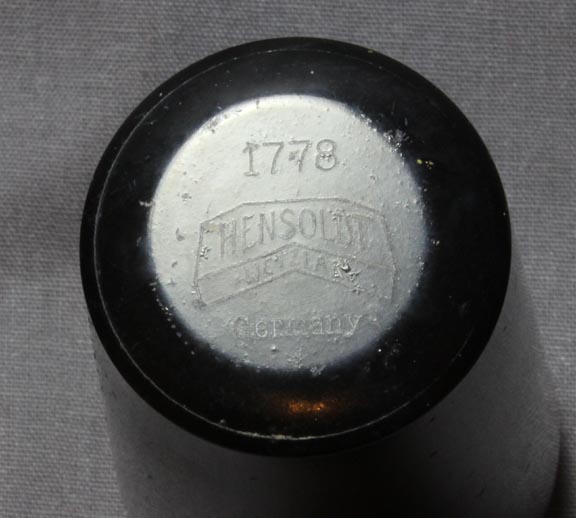 The microscope has a smooth semigloss black and chrome (or nickel) finish. It has a round base of about 1 3/4 inches in diameter. The height with all the drawtubes extended is about 7 5/8 inches. Height of the cover is about 3 7/8 inches. The microscope is signed:
The microscope has a smooth semigloss black and chrome (or nickel) finish. It has a round base of about 1 3/4 inches in diameter. The height with all the drawtubes extended is about 7 5/8 inches. Height of the cover is about 3 7/8 inches. The microscope is signed: HENSOLDT, WETZLARunder the focusing control ring. On the back of the instrument it is signed
D.R.P.a.which is the German abbreviation for
Patent Pending. On the top of the cover it is signed:
1778and in the insignia
HENSOLDT,.WETZLAR.Below the insignia it is signed
Germany.The focusing control simple threads the optical tube through the support ring. The stage is made of glass with a fixed angled mirror in the removeable base. The black stage clips attach to the ring around the base. There are two draw tubes, each calibrated with magnifications. The upper tube is calibrated from 40 to 115, the bottom from 42 to 110 There is a single eyepiece and a single objective.
THE LATER TAMI MODEL
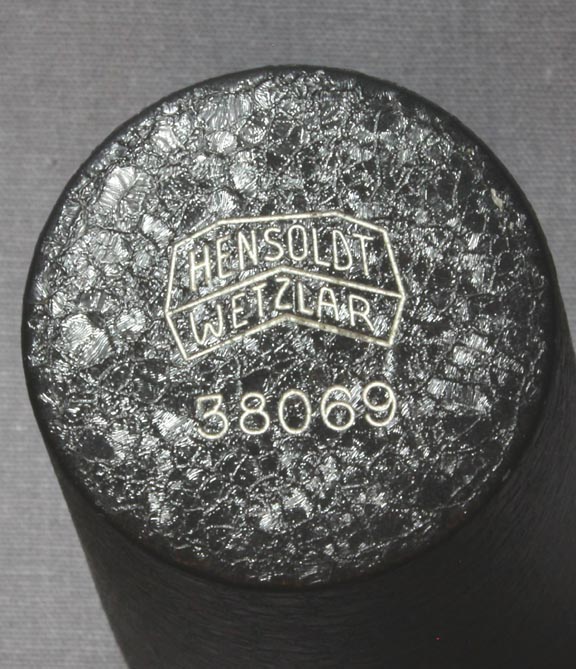 The later microscope has a 'crinkled' black and chrome finish. It has a round base of about 1 3/4 inches in diameter. The height with all the drawtubes extended is about 7 5/8 inches. Height of the cover is about 5 7/8 inches. The microscope is signed on the front:
The later microscope has a 'crinkled' black and chrome finish. It has a round base of about 1 3/4 inches in diameter. The height with all the drawtubes extended is about 7 5/8 inches. Height of the cover is about 5 7/8 inches. The microscope is signed on the front: Tamiabove the knurled focusing control and with the emblem with the words
HENSOLDT, WETZLARunder the control. On the back side, the microscope is signed with its serial number and below that, D.R.P. indicating it is patented in Germany. The top of the cover is signed with the newer insignia with the words:
HENSOLDT, WETZLARwith the serial number beneath the insignia. Note that this instrument has the newer insignia without the dots on each side of the word
WETZLARThe focusing control simple threads the optical tube through the support ring. The stage is made of glass with a fixed angled mirror in the removeable base. The black stage clips attach to the ring around the base. There are two draw tubes, each calibrated with magnifications. The upper draw is calibrated from 70 to 145 while the lower one is calibrated from 160 to 230. There is a single eyepiece and a single objective.
THE METAMI MODEL
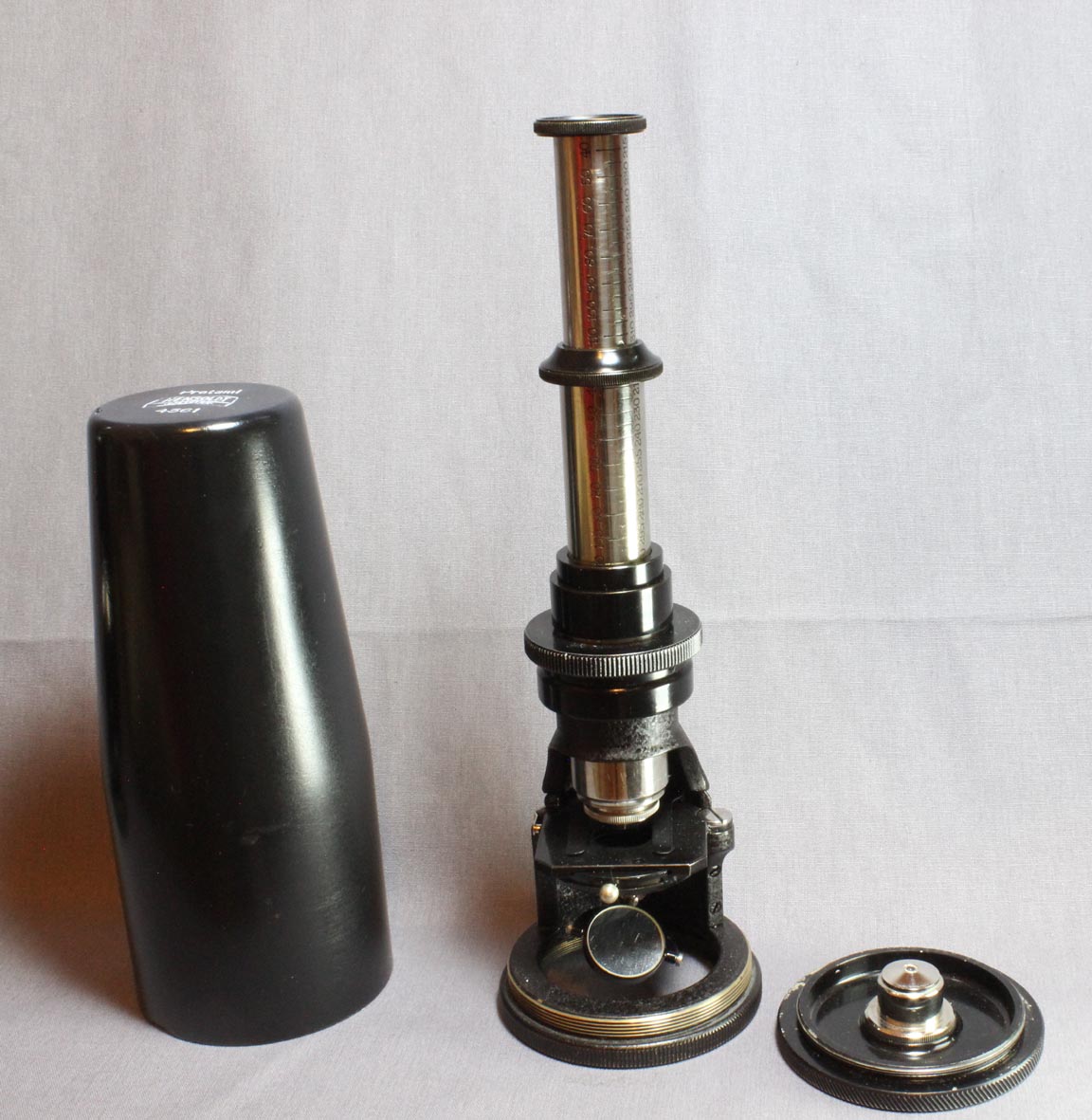
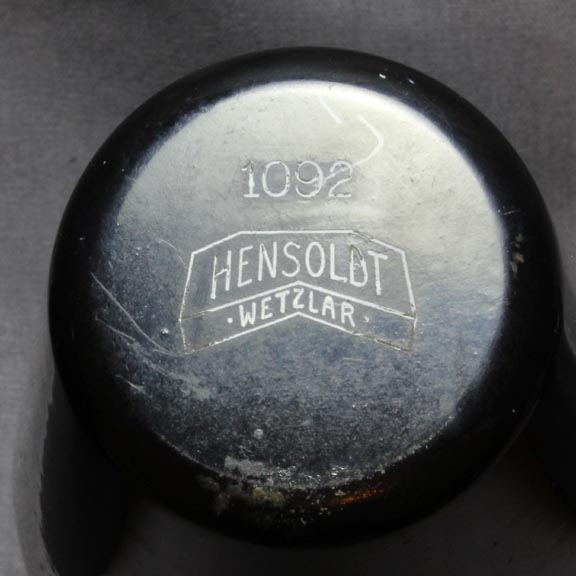 This microscope has a smooth semigloss black and chrome or nickel finish. It has a round base of about 2 5/8 inches in diameter. The height with both of the drawtubes extended is about 9 inches. Each draw tube is calibrated. The upper draw tube is calibrated from 40 to 115 and 215 to 315. The lower draw tube is calibrated from 40 to 110 and also from 215 to 310. Apparently one needed to add the magnification from each to arrive at the total. Height of the cover is about 5 3/4 inches. It is signed
This microscope has a smooth semigloss black and chrome or nickel finish. It has a round base of about 2 5/8 inches in diameter. The height with both of the drawtubes extended is about 9 inches. Each draw tube is calibrated. The upper draw tube is calibrated from 40 to 115 and 215 to 315. The lower draw tube is calibrated from 40 to 110 and also from 215 to 310. Apparently one needed to add the magnification from each to arrive at the total. Height of the cover is about 5 3/4 inches. It is signed HENSOLDT, WETZLARin the emblem on the back, and
D.R.P.below that; lower down it is signed
Metami, Vergr. 25-600. Vergr. is an abbreviation for the German word for magnification. Just below the focusing control is a sticker by a retailer, labelled
PALO COMPANY, NEW YORK. The D.R.P., which stands for Deutsches Reichspatent, is the German term for patent. The cover is signed with the serial number
1092above the insignia signed
HENSOLDT, WETZLAR.
THE PROTAMI MODEL
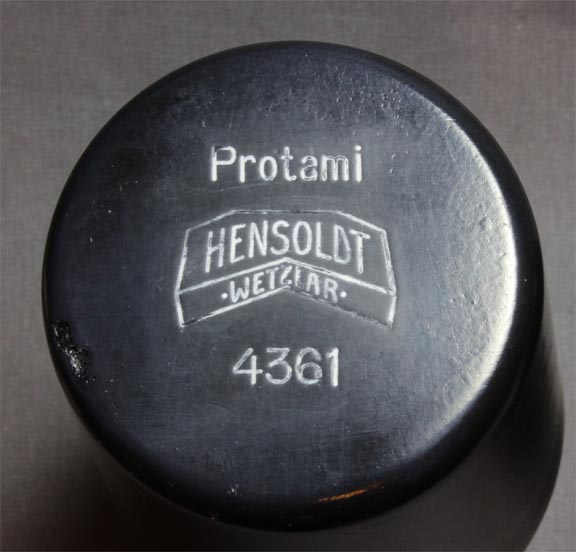
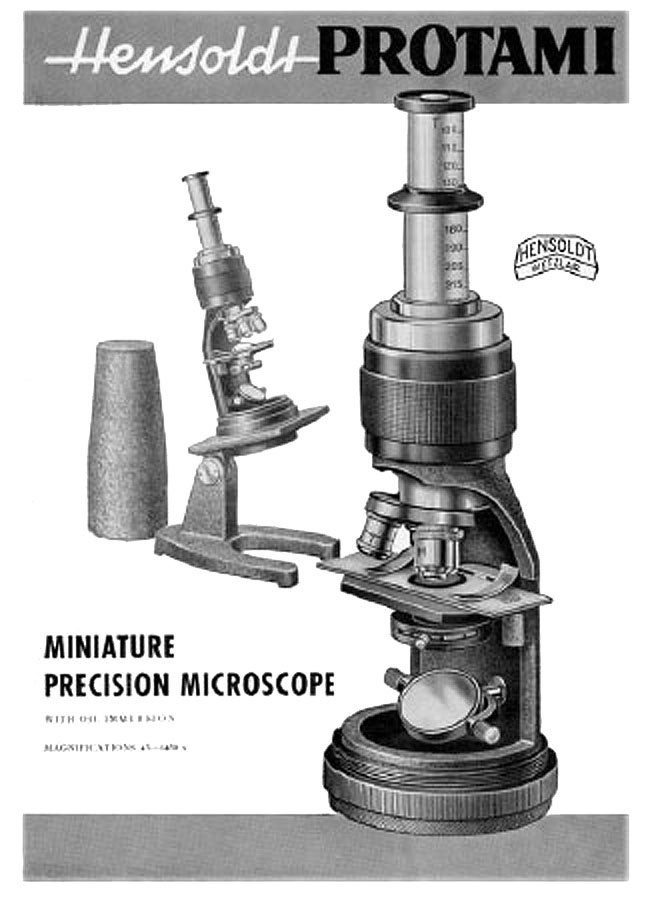 The cover of the Protami microscope has a smooth semigloss black finish. The microscope itself has a
The cover of the Protami microscope has a smooth semigloss black finish. The microscope itself has a crinkle blackfinish except for the stage and focusing knob which are a semigloss or flat black and some parts including the objectives have a nickel finish. It has a round base of about 1 3/4 inches in diameter. The height with all the drawtubes extended is about 7 5/8 inches. Height of the cover is about 6 1/4 inches. The back of the instrument is signed:
HENSOLDT, .WETZLAR.in the insignia. It is also signed
Protami, D.R.Pand
Vergr. 40-1200. The top of the cover is signed
Protamiabove the insignia signed
HENSOLDT, .WETZLAR.. Below the insignia is the serial number
4361
1/12, n.a. 1.3.The microscope could also be ordered with a 1/10 objective instead of a 1/12. The two draw tubes are each calibrated with sets of magnifications. The top draw tube is calibrated from 90 to 160 and also from 340 to 545. The bottom draw tube has three sets of calibration markings, one for each objective; 170 to 250, 565 to 760, and 880 to 1200. The stage can be turned aside just like the Metami, but instead of just an iris, it has a full substage condenser above the iris. The stage clips are made of a nickel finished metal. Like the Metami it has an articiated substage mirror. Unlike the Metami, there is no need for storage of another objective; their is a hole in the base. Just like the Tami, the Protami had an inclination attachment available for an extra charge. Just like the Metami, the focus control moves the optical tube without rotating it. Unlike the Tami and the Metami, the Protami has an oval cutout in its back. Later versions of the Protami cover had a crinkle finish similar to the microscope. Another feature was a small canister similar to a standard can for holding objectives which attached to the bottom of the stage. It housed a small vial of immersion oil. The top of the canister had a dovetail that slid into a dovetail slot on the bottom of the stage. My example has the dovetail slot under the stage but the can is missing.